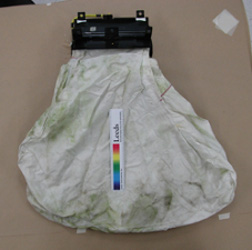Explosives, Fireworks, and Post-Blast Residues and Debris
Explosives and Post-Blast Residues Analysis
Engineering failures, pranks, sabotage, or even terrorism can cause explosions. When they occur, investigators must search for, analyze, and interpret evidence. This can help to shed light on the nature and origin of the events. In our lab, scientists have successfully applied trace evidence techniques and microchemical analysis methods to the examination of post-blast explosives residues and other evidence recovered during investigations. Our analytical experience covers a wide range of cases. These include terrorism (e.g., the Oklahoma City bombing), industrial explosions, and residential events.

Discharged airbag showing obvious combustion residue.
Post-blast residues (including gunshot residue) contain a great deal of valuable information. They can help to pinpoint the origin and the identity of an explosive. Associated trace evidence can provide even more investigative information. In some cases, it can help explain the cause of an explosion, the source of materials, or the individuals involved. In litigation, this information can help to identify the order of events or the cause of a failure. The entire spectrum of our lab’s analytical methods serve to address the unique questions of a given investigation.
Low Explosives and Fireworks (Pyrotechnics)
Low explosives are commonly used as pyrotechnics at concerts, festivals, celebrations, and sporting events. However, IEDs, pipe bombs, rocket propellants, and even fireworks have been used in street demonstrations and riots. Every year police and governmental authorities seize hundreds of tons of low explosives throughout the world.
Similar to larger scale explosive devices, these explosives are capable of releasing enough energy to produce molten reaction products- pyrotechnic reaction residue (PRR). Like gunshot residue (GSR), the combustion products quickly cool while still airborne and solidify into spheroidal shapes. The resulting residue is a mixture consisting of both unconsumed material and combustion products. In fact, the production, sampling, and analysis of pyrotechnic reaction residues are similar to that for GSR. However, analytical techniques must be adapted to the sample, since pyrotechnic reaction residue particles are typically produced in greater quantities and the chemical elements present in PRR are different and more varied than in GSR.

Sequential images of a Roman candle combustion, in which the fine mist of pyrotechnic reaction residue (PRR) can be observed.
Case Reviews
Microtrace’s scientists are regularly contacted to review the use of explosives residue findings in civil and criminal court proceedings. Our reviews consist of a critical examination of all aspects of a case. This includes sample collection, analytical details, interpretation, and testimony.
ATF License
Microtrace holds ATF Federal Explosives Licenses for Manufacturing. This license permits our scientists to analyze, manufacture, and store explosives. Microtrace has the ability to synthesize explosives and explosive devices to better characterize their properties. This includes understanding formulations, pathways for production, as well as the introduction of impurities.
See Also
Gunshot Residue Analysis (GSR Testing)
Related Standardized Methods
ASTM E2998 – 16: Standard Practice for Characterization and Classification of Smokeless Powder
How May We Help You?
Contact usto discuss your project in more detail.








